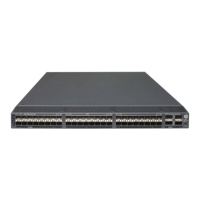46
Configuring the collaboration between Smart Link and Track
Smart Link collaborates with the CC function of CFD through track entries to implement link detection.
Before configuring the collaboration between Smart Link and Track on a port, make sure the port has
been added to the specified smart link group.
To configure the collaboration between Smart Link and Track:
Ste
Command
Remarks
1. Enter system view.
system-view N/A
2. Enter Layer 2 Ethernet
interface view or Layer 2
aggregate interface view.
interface interface-type
interface-number
N/A
3. Configure the collaboration
between Smart Link and Track
on the port.
port smart-link group group-id
track track-entry-number
By default, the collaboration
between Smart Link and Track is
not configured.
The track entry specified in the
command must be a track entry
that has been associated with the
CC function of CFD.
Configuring an associated device
Configuration prerequisites
Disable the spanning tree feature on the associated device's ports that connect to the member ports of
the smart link group. Otherwise, the ports will discard flush messages when they are not in forwarding
state if a topology change occurs.
Enabling the receiving of flush messages
You do not need to enable all ports on the associated devices to receive flush messages. Enable the
feature only on all control VLANs of ports on the primary and secondary links between the Smart Link
device and the destination device.
Follow these guidelines when you enable the receiving of flush messages:
• If no control VLAN is specified for processing flush messages, the device forwards the received flush
messages without any processing.
• Make sure the receive control VLAN is the same as the transmit control VLAN configured on the
Smart Link device. If they are not the same, the associated device will forward the received flush
messages directly without any processing.
• Do not remove the control VLANs. Otherwise, flush messages cannot be sent correctly.
• Make sure the control VLANs are existing VLANs, and assign the ports capable of receiving flush
messages to the control VLANs.
To enable the receiving of flush messages:

